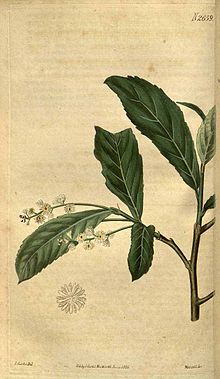bio.wikisort.org - Researcher
João de Loureiro (1717, Lisbon – 18 October 1791) was a Portuguese Jesuit missionary and botanist. [1]

Biography
After receiving admission to the Jesuit Order, João de Loureiro served as a missionary in Goa, capital of Portuguese India (3 years) and Macau (4 years). In 1742 he traveled to Cochinchina, remaining there for 35 years. Here he worked as a mathematician and naturalist for the king of Cochinchina,[2] acquiring knowledge on the properties and uses of native medicinal plants. In 1777, he journeyed to Canton, in Bengal, returning to Lisbon four years later.[3] During this period, the Captain Thomas Riddel gave Loureiro the books Systema Naturae, Genera Plantarum and Philosophia Botanica by Carl Linnaeus, which greatly influenced the Portuguese botanist.[4]
The first 40 years he stayed in Vietnam, João de Loureiro was inventorying indigenus herbal remedies. His local garden contained 1,000 unique herbal species, making him one of the greatest botanist collectors of the 18th century.[2]
João de Loureiro 1790, he published the book Flora Cochinchinensis sponsored by the Royal Portuguese Academy of Sciences.[4] João de Loureiro has numerous species "loureiroi" dedicated to him, mostly plants but also the dinosaur Draconyx loureiroi in honour of his being the first Portuguese palaeontologist.[5]
The taxonomist Elmer Drew Merrill later argued that Loureiro's work contained various mistakes caused by a misunderstanding of the Linnaean system.[4]
Standard author abbreviation
The standard author abbreviation Lour. is used to indicate this person as the author when citing a botanical name.[6]
Works

- Flora Cochinchinensis: sistens plantas in regno Cochinchina nascentes: quibus accedunt aliae observatae in Sinensi imperio, Africa orientali, Indiaeque locis variis: omnes dispositae secundum systema sexuale Linnaeanum
- Flora Cochinchinensis […] denuo in Germania edita, notes by Carl Ludwig Willdenow, 1793
- « On the nature and mode of production of Agallochum or aloes-wood », translated from Portuguese into English, in Tracts relative to botany, tr. from different languages, London, Phillips and Fardon […], 1805
Bibliography
- Pe. João de Loureiro : missionário e botânico by José Maria Braga, 1938.[7]
References
| Wikimedia Commons has media related to João de Loureiro. |
- "NATURALMENTE scienza - Padre Loureiro e la flora della Cocincina".
- John W. O'Malley & al (1 January 1999). The Jesuits: Cultures, Sciences, and the Arts, 1540-1773, Volume 1. University of Toronto Press. ISBN 9780802042873.
- JSTOR, Loureiro and his botanical work by E.D. Merrill Proceedings of the American Philosophical Society Vol. 72, No. 4 (Apr., 1933), pp. 229-239
- Britt-Louise Gunnarsson (28 October 2011). Languages of Science in the Eighteenth Century. Walter de Gruyter. ISBN 9783110255065.
- Mateus, O. and Antunes, M.T., 2001, January. Draconyx loureiroi, a new camptosauridae (Dinosauria, Ornithopoda) from the Late Jurassic of Lourinhã, Portugal. In Annales de paléontologie (Vol. 87, No. 1, pp. 61-73). Elsevier Masson.
- IPNI. Lour.
- WorldCat Titles Pe. João de Loureiro, etc.
На других языках
- [en] João de Loureiro
[ru] Лорейру, Жуан ди
Жуа́н ди Лоре́йру (порт. João de Loureiro; 8 сентября 1717 — 18 октября 1791) — португальский иезуит, миссионер, палеонтолог, медик и ботаник.Другой контент может иметь иную лицензию. Перед использованием материалов сайта WikiSort.org внимательно изучите правила лицензирования конкретных элементов наполнения сайта.
WikiSort.org - проект по пересортировке и дополнению контента Википедии